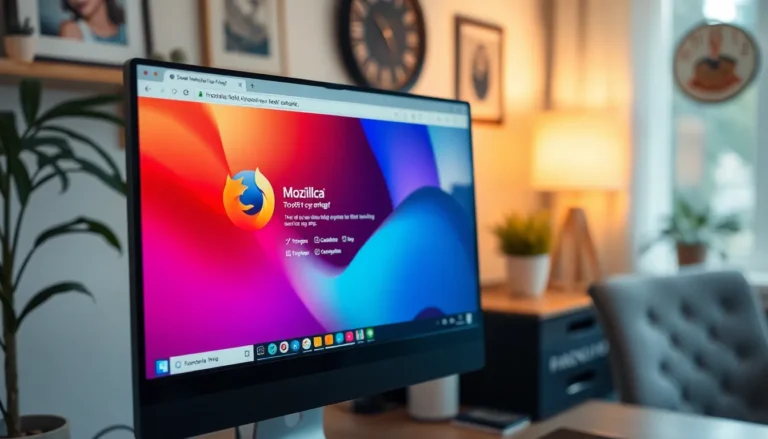Table of Contents
ToggleIn today’s digital age, screens are everywhere. From smartphones to tablets and TVs, it seems like everyone’s glued to a screen for one reason or another. But while binge-watching the latest series or scrolling through social media can feel like a guilty pleasure, it’s time to hit the pause button and consider the pros and cons of screen time.
On one hand, screens can be a gateway to knowledge, connection, and entertainment. On the flip side, they can also lead to couch potato syndrome and a serious case of eye strain. So, is screen time a blessing or a curse? Buckle up as we dive into the delightful yet daunting world of screens, exploring the good, the bad, and the surprisingly hilarious aspects of our screen-filled lives.
Overview of Screen Time
Screen time has become a significant aspect of everyday routines. People engage with screens through various devices, including smartphones, tablets, and televisions. This engagement can lead to both positive and negative experiences.
Benefits of screen time include access to information and educational content. Users can gain knowledge through online courses, tutorials, and articles. Furthermore, screens facilitate communication and connection between individuals, making it easier to maintain relationships across distances.
Digital entertainment offers another advantage. Streaming services and video games provide diverse options for relaxation and enjoyment. Many people find comfort and engagement in these activities, utilizing them as a way to unwind.
On the other hand, excessive screen time poses challenges. Sedentary lifestyles often result from prolonged use, contributing to health concerns such as obesity and cardiovascular diseases. Additionally, eye strain is a common complaint among those who use screens frequently, impacting overall comfort and productivity.
Sleep disturbances can also arise from late-night screen usage. Exposure to blue light from devices interferes with natural sleep patterns, affecting overall well-being. Children and adolescents may particularly suffer from the consequences, as developing minds require adequate rest.
Awareness of screen time’s pros and cons allows individuals to make informed choices. Balancing usage ensures that benefits are maximized while drawbacks are minimized. Understanding personal habits and limitations promotes healthier interactions with technology.
Pros of Screen Time
Screen time offers various advantages, contributing positively to modern life. Understanding these benefits can help individuals utilize screens more effectively.
Enhanced Learning Opportunities
Screens provide immediate access to educational resources. Online platforms offer courses on numerous topics, catering to different learning styles. Visual learning materials, such as videos and interactive simulations, engage learners better than traditional methods. Gamified learning experiences enhance motivation and retention of information. Furthermore, virtual classes allow participants to connect with educators worldwide, fostering global perspectives.
Social Connection and Networking
Digital screens play a crucial role in maintaining relationships. They enable instant communication through messaging and video calls, bridging distances effortlessly. Social media platforms allow users to share experiences and connect with others, expanding their networks. Participating in online communities nurtures a sense of belonging among those with similar interests. Collaboration tools facilitate teamwork, enhancing productivity across various fields.
Entertainment and Relaxation
Entertainment options through screens are virtually limitless. Streaming services provide access to movies and series, catering to diverse tastes. Video games offer immersive experiences that can relieve stress and promote relaxation. Creative outlets, such as digital art and music production, enable self-expression. Engaging with online content can serve as an escape from daily routines, contributing to mental well-being.
Cons of Screen Time
Screen time has several drawbacks that warrant consideration.
Impact on Physical Health
Increased screen time often correlates with sedentary behavior. This lack of movement significantly raises the risk of obesity and cardiovascular diseases. Eye strain becomes prevalent due to prolonged exposure to screens, leading to discomfort and visual disturbances. Additionally, poor posture while using devices can result in musculoskeletal issues. Engaging in regular breaks and physical activity helps mitigate these concerns. Recognizing these health risks is crucial for maintaining overall well-being.
Effects on Mental Well-being
Excessive screen time negatively impacts mental health. Reports indicate a strong link between high usage and increased symptoms of anxiety or depression. Social media use can create feelings of isolation despite the illusion of connectivity. Furthermore, the constant barrage of information may overwhelm the mind, contributing to stress and reducing attention span. Prioritizing offline activities nurtures better mental health and resilience against these adverse effects.
Distraction and Reduced Productivity
Screens often provide significant distractions in both work and learning environments. Notifications interrupt focus, hindering task completion and productivity. Research highlights that multitasking between screens can decrease efficiency. This behavior leads to lower quality work and increased time wasted on trivial activities. Setting boundaries for screen usage fosters a more productive atmosphere, encouraging deeper engagement with important tasks.
Balancing Screen Time
Balancing screen time involves recognizing its advantages and setting boundaries to address its drawbacks. Individuals can improve their well-being by adopting thoughtful screen usage strategies.
Setting Limits for Healthy Use
Establishing defined screen time limits promotes healthier habits. Setting daily usage goals for adults and children can enhance awareness of screen time’s impact. Monitoring usage through apps or timers helps in maintaining these limits. Allocating specific hours for recreational screen activities ensures downtime. Creating device-free zones, like during meals or in bedrooms, fosters face-to-face interactions and better sleep hygiene. Reducing screen time to two hours daily, as recommended by the American Academy of Pediatrics, can significantly improve overall health.
Alternatives to Screen Activities
Exploring alternatives to screens opens up enriching experiences. Engaging in physical activities, like hiking or cycling, promotes fitness and social connections. Reading books or playing board games encourages creative thinking and family bonding. Pursuing hobbies such as painting, gardening, or cooking provides productive outlets for energy. Socializing in person with friends and family helps strengthen relationships outside of the digital realm. Integrating these activities into daily routines supports a balanced lifestyle, maximizing benefits while minimizing screen time’s drawbacks.
Navigating the world of screen time requires a thoughtful approach. While screens offer numerous benefits including enhanced learning and social connectivity, they also pose risks to physical and mental health. Striking a balance is essential for maximizing the positive aspects while minimizing the negative impacts. By setting reasonable limits and encouraging offline activities, individuals can foster healthier habits and improve overall well-being. Embracing a mindful approach to screen usage not only enriches daily life but also strengthens relationships beyond the digital realm. Making informed choices about screen time can lead to a more fulfilling and balanced lifestyle.





